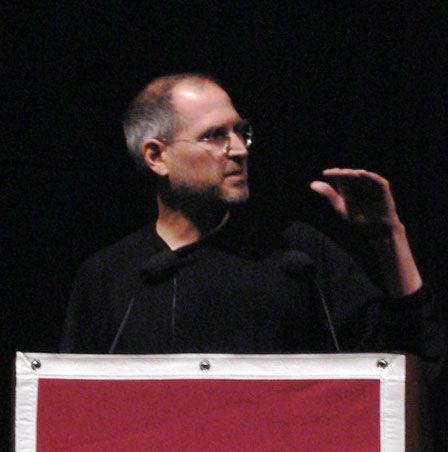Monolithic Apple looks for fresh adventures


Apple has built its monolithic empire on the back of revolutionary, disruptive product launches which immediately ascend to dominate the market they enter (or in some cases create). With the iPod and iTunes Apple moved in and took over the digital music space, with the iPhone it transformed the mobile phone/PDA space and then with the iPad it more or less invented the tablet space.
The announcement of each new product line is engineered to whip the press into a frenzy of rabid excitement and Apple is uniquely able to launch the product almost immediately afterwards while the hyperbole is still ringing in our ears.
This strategy ensures the product gets off to a roaring start, and the next few years are spent delivering upgrades and enhancements which leave competitors scrambling to catch up.
However, after a while the excitement begins to wane, and the updates struggle to live up to the stratospheric expectations Apple itself has created. A few dissenting voices start to emerge from the crowd to lay the seeds of doubt in our minds; maybe Apple has finally run out of ideas, they say.
The reaction to the new iPad makes it feel like that moment has arrived. Granted there was still huge excitement and queues outside Apple stores around the world, but there were also those who expressed disappointment, including Hector Dish in his own TechEye column.
Whether you agree with these voices or not, there’s no denying that Apple’s most recent product launches have been evolutionary rather than revolutionary products. However, Apple is well aware that maintaining its divine image of world-changing innovation means being ready to feed the consumer’s insatiable appetite for the next big thing, and behind the scenes they are no doubt cooking up a feast.
But what could the next revolutionary Apple product be? The desktop market has long since matured, the iPhone has allowed Apple to take a leading stake in the mobile space and with the iPad it has been able to open up a new market which sits somewhere between the two. However, there is still one space in our lives that Apple is yet to disrupt; the space in front of the TV.
It’s been widely rumoured for a while now that Apple is working on a new, paradigm-changing version of Apple TV, after a juicy hint was dropped in Walter Issacson’s biography of Steve Jobs: “He very much wanted to do for television sets what he had done for computers, music players and phones: make them simple and elegant”
If you look at the transition from each Apple product line to the next with the benefit of hindsight, you see a pattern emerge. The iPod laid the ground work for iPhone, by popularising digital media on the go and establishing iTunes as a delivery platform. The iPhone in turn laid the ground work for iPad, by establishing the App Store and bringing the magic of multi-touch screens to the masses.
Similarly the iPhone 4S with its Siri voice recognition system and the new iPad with its much hyped HD screen have surely provided some tantalising clues about Apple’s next big move.
The App Store is home to a colossal ecosystem of brilliant content, but none of it has native access to what is still arguably the most important screen in the home; the TV screen. If Apple wants to address that space, as it surely must, then two things are required. First it needs all the content on the App Store to be upgraded to HD, and secondly it needs to develop a new interface for interacting with that content because unless you’re Mr Tickle, a touch screen isn’t going to work.
Of course, launching a revolutionary TV product and then asking developers to upgrade all their apps to HD afterwards is not ideal, but by adding an HD screen to an established product like the new iPad, Apple has ensured the transition is well underway. Meanwhile, speculation has already been circulating that Siri could be a forerunner to the interface people will use to interact with such a product, or at least part of it. Perhaps a Wii-style motion controller or connected iPad will allow users to interact in a more tactile manor with apps designed for a touch screen interface?
Apple’s old rival Microsoft is already pushing in this space. Their Xbox 360 games console has been ferociously expanding the content it can serve up to the humble TV; with Netflix, Lovefilm, Sky TV, BBC iPlayer, Facebook, Twitter, and more now pouring onto their Xbox LIVE service. Each can be elegantly navigated with the sweep of a hand or by voice command thanks to the hugely successful Kinect sensor, and Microsoft’s next-generation console is rumoured to be lining up for a Christmas 2013 launch. Microsoft are not alone; Sony’s PlayStation console boasts many of the same services and features and TV manufacturers are now producing Internet enabled TVs in an effort to capture the potential of this market.
Apple is hardly going to sit back and let these players control the fate of the living room, especially as they have a treasure trove of great App Store content at their beck and call.
Since the new iPad launched the clarity of its Retina display has been the talk of tech-town, but perhaps its most profound implication is yet to come into focus; that it opens a window into the world of Apple’s next revolutionary product and possibly the last one to be masterminded by the late Steve Jobs, as the man himself hinted in Walter Issacson’s biography: “’I’d like to create an integrated television that is completely easy to use,’ he told me… ‘It will have the simplest user interface you could imagine. I finally cracked it.’”
Recent Posts
Flashpoint enters new chapter with global partner programme
Security vendor Flashpoint debuts partner programme following $28m funding
Channel partner “disconnect” hindering growth
Complex buying journeys and sprawling partner networks hampering customer experience, says Accenture
Cyxtera launches global channel partner programme
Datacentre provider Cyxtera says launch is “milestone in our go-to-market strategy”
US IT provider brings mainframe services to UK
Ensono highlights importance of mainframes still to major industries
VASCO and Nuvias expand distribution across EMEA
Security vendor VASCO looks to replicate UK and German set up across EMEA
Splunk says channel investments driving growth
Splunk details investment in Partner+ programme at .conf2017

